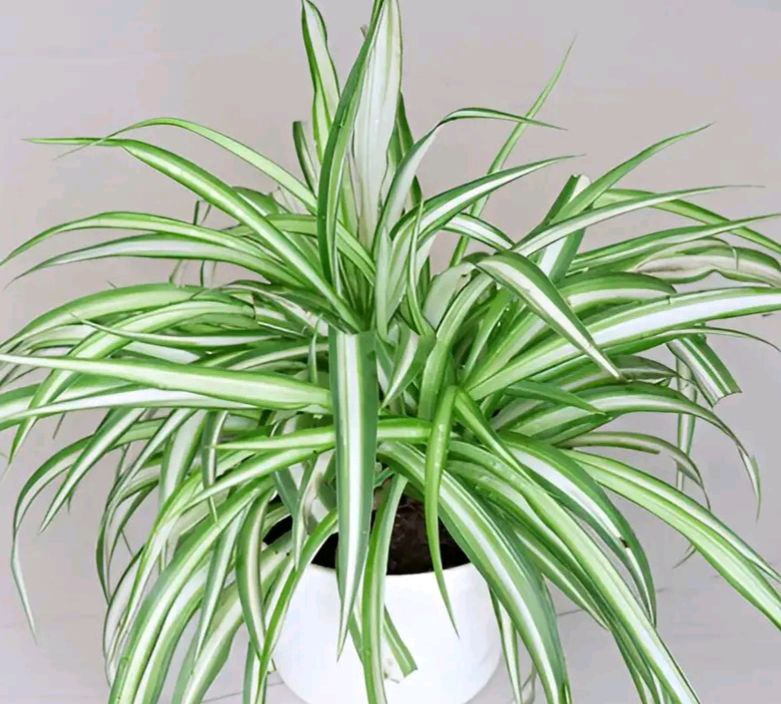
Spider plants (Chlorophytum comosum), also known as airplane plants or ribbon plants, are cherished houseplants renowned for their graceful arching leaves and ease of care. it is native to tropical and southern Africa, however, these resilient plants have become a staple in homes worldwide, thanks to their air-purifying qualities and charming “spiderettes” or baby plants that dangle from long stems. It’s both pretty and fun to grow.
If you’re new to houseplants, this guide will help you care for your spider plant and teach you how to grow more from the one you already have.
Light Requirements
Spider plants thrive in bright, indirect sunlight. While they can tolerate lower light conditions, insufficient light may lead to slower growth and less vibrant foliage. Avoid direct sunlight, which can scorch their leaves. Placing them near an east-facing window or a spot with scattered light is ideal.
Watering Needs
Maintaining consistent moisture is key. Water your spider plant when the top inch of soil feels dry to the touch. Overwatering can lead to root rot, while underwatering may cause the leaf tips to brown. Spider plants don’t like soggy soil. Using rainwater or filtered water is beneficial, as spider plants are sensitive to fluoride and chlorine, which are commonly found in tap water.
Temperature and Humidity
Spider plants prefer temperatures between 65°F to 75°F (18°C to 24°C). They can tolerate occasional temperature drops but should be protected from cold drafts. Average household humidity levels are sufficient, but they also appreciate occasional misting, especially in drier environments.
Soil and Fertilization
Use a well-draining potting mix rich in organic matter. A combination of peat moss, perlite, and compost works well. Fertilize your spider plant monthly during the growing season (spring and summer) with a balanced, water-soluble fertilizer diluted to half strength. Over-fertilization can lead to brown leaf tips and reduced plantlet production.
Pruning and Maintenance
Regular pruning helps maintain the plant’s appearance and encourages new growth. Remove any yellowing or brown leaves by cutting them at the base. If the plant becomes too large or produces numerous spiderettes, you can trim the long stems to manage its size and shape.
Repotting
Spider plants prefer to be slightly root-bound, which can encourage the production of spiderettes. However, when roots start to outgrow the pot or emerge from drainage holes, it’s time to repot. Choose a pot that’s 1-2 inches larger in diameter and refresh the soil to provide new nutrients.
Pet-Friendly Plant
Good news for pet owners: spider plants are non-toxic to cats and dogs. However, their dangling spiderettes can be tempting toys, so monitor your pets to prevent any potential messes.
Propagation Methods
One of the joys of owning a spider plant is the ease with which you can propagate new plants. Here are the primary methods:
1. Propagating Spiderettes (Plantlets)
Spider plants produce small offshoots, or “spiderettes,” that can be rooted to grow new plants. Wait until the spiderette has developed small roots. Then, using clean scissors, snip it from the mother plant and plant it in a pot with well-draining soil. Keep the soil moist until the new plant establishes itself.
2. Water Propagation
Alternatively, you can place the spiderette in a glass of water, ensuring only the roots are submerged. Place the glass in a spot with bright, indirect light. Change the water every few days. Once roots are about 1-2 inches long, transplant the spiderette into soil.
3. Division
For mature plants, you can divide the root ball during repotting. Gently separate the plant into sections, ensuring each has a healthy root system, and plant them in individual pots. This method is effective for rejuvenating older plants and expanding your collection.
Common Issues and Solutions
- Brown Leaf Tips: Often caused by fluoride in tap water, low humidity, or over-fertilization. Use distilled water and ensure you’re not overfeeding your plant.
- Pests: Spider plants are generally pest-resistant but can occasionally attract aphids, mealybugs, or spider mites. Treat infestations with insecticidal soap or neem oil.
- Lack of Spiderettes: A young plant, insufficient light, or a pot that’s too large can delay spiderette production. Please make sure your plant receives adequate light and is slightly root-bound.
Embracing the Beauty of Spider Plants
Spider plants are more than just decorative greenery; they’re resilient, air-purifying companions that bring life to any indoor space. With minimal care and a bit of attention, they reward you with lush foliage and the joy of propagating new plants. Whether adorning a hanging basket or brightening a shelf, spider plants are a delightful addition to your home.
